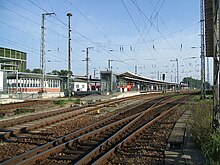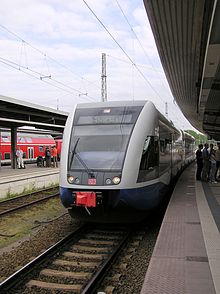Stralsund Hauptbahnhof
| Through station | |
 Entrance of station building | |
| General information | |
| Location | Stralsund, Mecklenburg-Vorpommern Germany |
| Coordinates | 54°18′31″N 13°04′38″E / 54.30861°N 13.07722°E |
| Line(s) |
|
| Platforms | 3 |
| Construction | |
| Architect | Alexander Rüdell |
| Architectural style | Gothic Revival |
| Other information | |
| Station code | 6049 |
| DS100 code | WSR[1] |
| IBNR | 8010338 |
| Category | 3[2] |
| History | |
| Opened | 1 January 1878 |
| Key dates | |
| 1905 | Rebuilt 28 March |
Stralsund Hauptbahnhof is the main station in Western Pomerania and the main station for railway lines running to Hamburg, Bergen auf Rügen and Berlin in the German Hanseatic city of Stralsund. It is owned and operated by Deutsche Bahn.
Station
Construction of the present-day station near the centre of the city started on 9 November 1903 and it was inaugurated on 28 March 1905.

Its predecessor was a wooden building constructed in 1863 in the suburb of Tribseer Vorstadt. The construction of this station and the railway to Stralsund had been promoted by the merchants and entrepreneurs of Stralsund since 1844. They joined together in the same year as the "Society for the attainment of a railway from Berlin via Neu-Strelitz to Stralsund" (Template:Lang-de) and set out its proposals in a memorandum.[3] They also put this matter before the competent authorities in Berlin. The association developed a concept for the construction of the line and accumulated large financial resources. These efforts, however, always failed at the Prussian Ministry in Berlin and the proposals were refused in the 1840s and 1850s. Finally in 1863 a branch line from Angermünde was built from the Berlin–Stettin line (which had opened in 1843) via Prenzlau, Pasewalk, Anklam and Greifswald to Stralsund. On 26 October 1863 the line reached Stralsund. Due to the nature of Stralsund as a fortress, the station building was built only of wood at the instigation of the Prussian war ministry. In the event of an attack on the city, the building could be destroyed quickly. The building measured about 30 × 10 metres and had two waiting rooms. The platforms were not covered, and passengers had to walk along the tracks to reach the platforms.
Despite its initial success in having the branch from Angermünde built, the Stralsund Society continued to campaign for a direct connection, known as the "Northern Railway". In 1869 a plan was prepared for the laying of a railway line from Berlin to Neustrelitz, Stralsund and Cape Arkona, including a fixed crossing of the Strelasund, which was not realized until 1936. The opening of the Prussian Northern Railway to its terminus at Stralsund was finally celebrated on 1 January 1878, with the arrival of the first train from Berlin.
After the demilitarisation of Stralsund, the call for a new, more modern and higher capacity station became louder. The new station was built of brick and opened to traffic on 29 March 1905. The design for the station building was prepared by the Royal Railway Directorate in Stettin (now Szczecin). The processing of the detailed architectural design and construction management was supervised by Alexander Rüdell, with its implementation handled by Hans Stubbe, who was later a professor at the Braunschweig University of Technology.
A tower next to the hall, which houses a staircase, represents the architecture of the three parishes of greater Stralsund. The entrance hall is 22.12 metres long, 9.90 metres wide and almost 15 metres high. Above the entrance and access to the platforms are large glass facades. Station services were located in the western area of the hall. Three waiting rooms were built in the eastern area: one for ladies only, one for 1st and 2nd class passengers and one for 3rd and 4th class passengers. Access to the six platforms became somewhat easier, although travellers who wished to use the line to Rostock opened in 1888 had to continue to cross the tracks. Only later was a tunnel built. The three platform tracks for trains to and from Rostock are through tracks. The other three platforms (1 - 3) were built as terminal tracks.

The station building was built on the area of a former cattle loading ramp on Tribseer Damm (street). Originally there was an area for the operation of carriages to pick up passengers to depart from the station. Later a tramway and a light railway were opened. Today there is short-term parking and a taxi rank in this area.
On the evening of 28 March 1905 a festival was held to dedicate the new station. This lasted until the early morning hours, with the departure of train No. 206 to Neubrandenburg.[4]
In the 1930s, the Stralsund artist Erich Kliefert received a commission to design the lobby. He placed a large colour display of Stralsund from the air on the western side at the top of the hall and on the eastern side there is a similar representation of the island of Rügen.
In the 1990s the building was refurbished and the area in front of the platforms was covered with a large glass structure. The sanitary facilities were renovated and shops were established in the station.
Train services

The station is served by the following services:[5]
- Intercity-Express services (ICE 15) (Binz -) Stralsund - Eberswalde - Berlin - Erfurt - Frankfurt
- Intercity-Express services (ICE 28) (Binz -) Stralsund - Eberswalde - Berlin - Leipzig - Jena - Nuremberg - Munich (- Innsbruck)
- Intercity services (IC 26) Binz - Stralsund - Rostock - Hamburg - Hannover - Kassel - Frankfurt (Main) - Karlsruhe
- Intercity services (IC 30) Binz - Stralsund - Rostock - Hamburg - Münster - Duisburg - Köln - Mainz - Karlsruhe
- Intercity services (IC 32) Binz - Stralsund - Eberswalde - Berlin - Hanover - Dortmund - Essen - Duisburg - Düsseldorf - Cologne
- Regional services RE 3 Stralsund - Greifswald - Pasewalk - Angermünde - Berlin - Ludwigsfelde - Jüterbog - Falkenberg - Elsterwerda
- Regional services RE 5 Stralsund - Neustrelitz - Berlin - Wünsdorf-Waldstadt - Elsterwerda
- Regional services RE 9 Rostock - Velgast - Stralsund - Lietzow - Sassnitz/Binz
- Local services UBB 1 Barth- Velgast - Stralsund
- Local services UBB 2 Stralsund - Greifswald - Züssow - Wolgast - Heringsdorf - Świnoujście
| Preceding station | Deutsche Bahn | Following station | ||
|---|---|---|---|---|
toward Template:DB-ICE stations | Template:DB-ICE lines | toward Template:DB-ICE stations |
||
| Terminus | Template:DB-ICE lines | toward Template:DB-ICE stations |
||
toward Template:DB-IC stations | Template:DB-IC lines Karlsruhe | toward Template:DB-IC stations |
||
toward Template:DB-IC stations | Template:DB-IC lines | toward Template:DB-IC stations |
||
toward Template:DB-IC stations | Template:DB-IC lines | toward Template:DB-IC stations |
||
| Terminus | Template:RE-MV lines | toward Template:RE-MV stations |
||
| Terminus | Template:RE-MV lines | toward Template:RE-MV stations |
||
toward Template:RE-MV stations | Template:RE-MV lines | toward Template:RE-MV stations |
||
| Preceding station | Usedomer Bäderbahn | Following station | ||
toward Template:RB-MV stations | Template:RB-MV lines | Terminus | ||
| Terminus | Template:RB-MV lines | toward Template:RB-MV stations |
Notes
- ^ Eisenbahnatlas Deutschland (German railway atlas) (2009/2010 ed.). Schweers + Wall. 2009. ISBN 978-3-89494-139-0.
- ^ "Stationspreisliste 2024" [Station price list 2024] (PDF) (in German). DB Station&Service. 24 April 2023. Retrieved 29 November 2023.
- ^ “Vorläufige Ansichten über eine Berlin-Stralsunder Eisenbahn“. Stralsund 1844
- ^ Stralsunder Tageblatt (in German). 29 March 1905.
{{cite news}}: Missing or empty|title=(help) - ^ Timetables for Stralsund Hbf
References
- Neumerkel, Andreas (19 January 2005). "Stralsunder Hauptbahnhof wird 100 Jahre alt" (in German). Ostsee-Zeitung.
- Ewe, Herbert (1984). Geschichte der Stadt Stralsund (in German). Weimar: Hermann Böhlaus Nachfolger.
- Birkholz (1921). "Der Bahnhof in Stralsund". Zentralblatt der Bauverwaltung (in German). 41 (51): 313–315.
